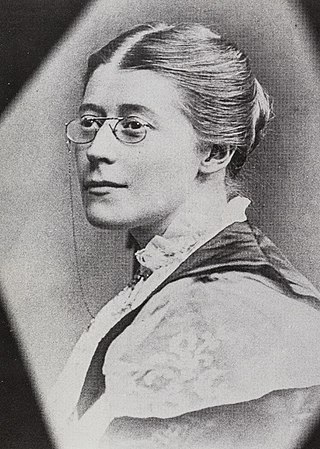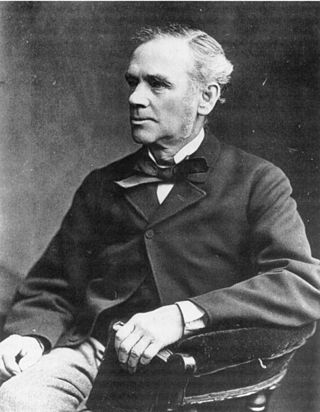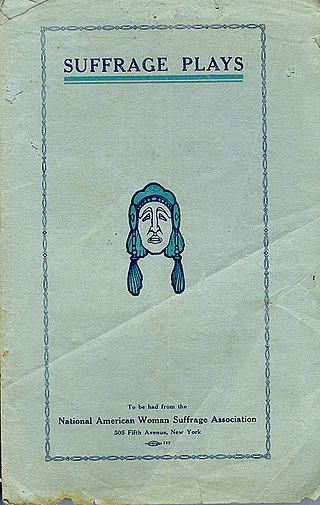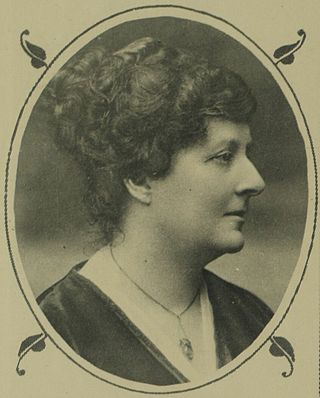
Emmeline Pankhurst was an English political activist who organised the UK suffragette movement and helped women win the right to vote. In 1999, Time named her as one of the 100 Most Important People of the 20th Century, stating that "she shaped an idea of objects for our time" and "shook society into a new pattern from which there could be no going back". She was widely criticised for her militant tactics, and historians disagree about their effectiveness, but her work is recognised as a crucial element in achieving women's suffrage in the United Kingdom.

The National Union of Women Suffrage Societies (NUWSS), also known as the suffragists was an organisation founded in 1897 of women's suffrage societies around the United Kingdom. In 1919 it was renamed the National Union of Societies for Equal Citizenship.

The United Procession of Women, or Mud March as it became known, was a peaceful demonstration in London on 9 February 1907 organised by the National Union of Women's Suffrage Societies (NUWSS) in which more than 3,000 women marched from Hyde Park Corner to the Strand in support of women's suffrage. Women from all classes participated in what was the largest public demonstration supporting women's suffrage seen until then. It acquired the name "Mud March" from the day's weather since incessant heavy rain left the marchers drenched and mud-spattered.

Esther Roper was an Irish-English suffragist and social justice campaigner who fought for equal employment and voting rights for working-class women.

A movement to fight for women's right to vote in the United Kingdom finally succeeded through acts of Parliament in 1918 and 1928. It became a national movement in the Victorian era. Women were not explicitly banned from voting in Great Britain until the Reform Act 1832 and the Municipal Corporations Act 1835. In 1872 the fight for women's suffrage became a national movement with the formation of the National Society for Women's Suffrage and later the more influential National Union of Women's Suffrage Societies (NUWSS). As well as in England, women's suffrage movements in Wales, Scotland and other parts of the United Kingdom gained momentum. The movements shifted sentiments in favour of woman suffrage by 1906. It was at this point that the militant campaign began with the formation of the Women's Social and Political Union (WSPU).

Hugh Mason was an English mill owner, social reformer and Liberal politician. He was born in Stalybridge and brought up in Stalybridge and Ashton-under-Lyne until he entered the family cotton business in 1838 after a seven-year period working in a bank. Having originally opposed trade unions, Mason became a paternalistic mill owner, creating a colony for his workers with associated facilities and ensuring that they experienced good conditions. During the Lancashire Cotton Famine of the 1860s he refused to cut workers' wages although it was common practice.

A suffragette was a member of an activist women's organisation in the early 20th century who, under the banner "Votes for Women", fought for the right to vote in public elections in the United Kingdom. The term refers in particular to members of the British Women's Social and Political Union (WSPU), a women-only movement founded in 1903 by Emmeline Pankhurst, which engaged in direct action and civil disobedience. In 1906, a reporter writing in the Daily Mail coined the term suffragette for the WSPU, derived from suffragist, in order to belittle the women advocating women's suffrage. The militants embraced the new name, even adopting it for use as the title of the newspaper published by the WSPU.

Helen Bright Clark (1840–1927) was a British women's rights activist and suffragist. The daughter of a radical Member of Parliament, Clark was a prominent speaker for women's voting rights and at times a political realist who served as a mainstay of the 19th century suffrage movement in South West England. A liberal in all senses, Clark aided progress toward universal human brotherhood through her activities in organisations which assisted former slaves and aboriginal peoples.

The Open Christmas Letter was a public message for peace addressed "To the Women of Germany and Austria", signed by a group of 101 British suffragists at the end of 1914 as the first Christmas of the First World War approached. The Open Christmas Letter was written in acknowledgment of the mounting horror of modern war and as a direct response to letters written to American feminist Carrie Chapman Catt, the president of the International Woman Suffrage Alliance (IWSA), by a small group of German women's rights activists. Published in January 1915 in Jus Suffragii, the journal of the IWSA, the Open Christmas Letter was answered two months later by a group of 155 prominent German and Austrian women who were pacifists. The exchange of letters between women of nations at war helped promote the aims of peace, and helped prevent the fracturing of the unity which lay in the common goal they shared, suffrage for women.

Annie Shepherd Swan, CBE was a Scottish journalist and fiction writer. She wrote mainly in her maiden name, but also as David Lyall and later Mrs Burnett Smith. A writer of romantic fiction for women, she had over 200 novels, serials, stories and other fiction published between 1878 and her death. She has been called "one of the most commercially successful popular novelists of the later nineteenth and early twentieth centuries". Swan was politically active in the First World War, and as a suffragist, a Liberal activist and founder-member and vice-president of the Scottish National Party.

Suffrage drama is a form of dramatic literature that emerged during the British women's suffrage movement in the early twentieth century. Suffrage performances lasted approximately from 1907-1914. Many suffrage plays called for a predominant or all female cast. Suffrage plays served to reveal issues behind the suffrage movement. These plays also revealed many of the double standards that women faced on a daily basis. Suffrage theatre was a form of realist theatre, which was influenced by the plays of Henrik Ibsen. Suffrage theatre combined familiar everyday situations with relatable characters on the stage in the style of realist theatre.

Nessie Stewart-Brown JP was a British suffragist and Liberal Party politician. Her name and picture is on the plinth of the statue of Millicent Fawcett in Parliament Square.

The Liverpool Women's Suffrage Society was set up in 1894 by Edith Bright, Lydia Allen Booth and Nessie Stewart-Brown to promote the enfranchisement of women. The society held its first meeting in a Liverpool temperance hall, with Millicent Fawcett, head of the National Union of Women's Suffrage Societies (NUWSS), as its guest speaker. The society set up headquarters in Lord Street. The group became affiliated with the NUWSS in 1898, it held meetings in cafés which included talks, poetry and dance recitals. Members were recruited from prominent members of society and they distanced themselves from working class suffrage societies such as Women's Social and Political Union (WSPU).

Women's suffrage in Wales has historically been marginalised due to the prominence of societies and political groups in England which led the reform for women throughout the United Kingdom. Due to differing social structures and a heavily industrialised working-class society, the growth of a national movement in Wales grew but then stuttered in the late nineteenth century in comparison with that of England. Nevertheless, distinct Welsh groups and individuals rose to prominence and were vocal in the rise of suffrage in Wales and the rest of Great Britain.
Eva Maria McLaren was an English suffragist, writer and campaigner. She served as Superintendent of the Franchise department of the World's Woman's Christian Temperance Union. She was actively associated with the Woman's Liberal Federation, and was the Vice-President of the National British Women's Temperance Association. In this capacity, she presided over and lead the white ribbon forces in England when the President, Lady Henry Somerset, was absent from the post.
Sarah Dickenson OBE was a British trade unionist and feminist activist.
This is an overview of Women's Suffrage activism and local politics as experienced in Leigh, Lancashire between 1900 and 1914.
Jessie Cunningham Methven was a Scottish campaigner for women's suffrage. She was honorary secretary of the Edinburgh National Society for Women's Suffrage from the mid 1890s until 1906. She subsequently joined the more militant Women's Social and Political Union and described herself as an "independent socialist".

The Historiography of the Suffragette Campaign deals with the various ways Suffragettes are depicted, analysed and debated within historical accounts of their role in the campaign for women's suffrage in early 20th century Britain.
Margaret Aldersley (1852–1940) was a British suffragist, feminist and trade unionist.














